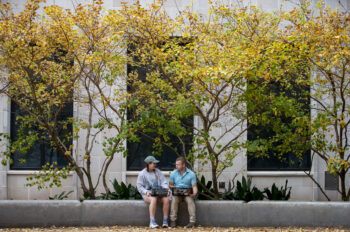Dr. Carol Loopstra considers herself a tree nerd.
“I love knowing what the different types of trees are, and I have an appreciation for how important they are to us,” said Loopstra, an associate professor in Texas A&M University’s Department of Ecology and Conservation Biology.
For more than 20 years, Loopstra has been sharing her enthusiasm for trees through Forest Trees of North America, a course that covers tree identification as well as their ecological and social uses and benefits.
“I just get really excited when I can get a student excited about trees,” she said.

Trees are a crucial part of the environment, providing wood and paper products, oxygen, carbon sequestration, wildlife habitat, shade and even health benefits, Loopstra said.
“Trees are important for a lot of things,” Loopstra said, and they deserve to be celebrated.
Just such a celebration will happen on Friday, Texas Arbor Day, which aims to promote the value of trees and healthy forests while encouraging people to plant trees.
National Arbor Day is observed in April, but Texas Arbor Day is celebrated the first Friday in November to mark the beginning of the ideal time to plant trees in the Lone Star State.
Staff members from Texas A&M Forest Service will spend the day visiting school campuses to give tree care presentations and plant trees. The agency will give away more than 8,000 tree seedlings in communities across the state.
Texas A&M Forest Service also has a tree-selection guide to help people find the best trees for their location and their needs, as well as tree-planting instructions.
Texas A&M University, which first earned its Tree Campus USA designation from the Arbor Day Foundation in 2010, will mark the day with its own tree planting, said JJ Aguilar, who manages a seven-person team that cares for more than 11,000 trees on campus.
Most of the trees on campus are live oaks, Aguilar said, but there are also plenty of crepe myrtles, Shumard oaks, water oaks, bur oaks, American sycamore, American and Chinese elm trees and a variety of other species.
Aguilar said his team expects to add more than 110 trees to campus this planting season.
On Saturday, student volunteers from Aggie Replant will plant hundreds of trees across the Bryan-College Station community. The group’s annual tree planting event began in 1991 and has grown to become what organizers say is the largest student-run environmental service project in the country.
Loopstra, whose research focuses on the genomics and molecular biology of loblolly pine trees, said trees have benefits to the ecosystem as a whole.
“It’s not just an individual tree,” she said. “If something happens to your trees because of drought or insects or diseases, it doesn’t just affect that tree. It affects the whole ecosystem, the animals that lived in it, the soil that it grows in and so much more.”
And, she said, there’s a demand for people with expertise in the field.
“The good thing for students interested in forestry,” she said, “is it’s a profession with a lot of jobs. The number of roles that foresters fill has grown over the years. If somebody is interested in natural resources, it’s an area that has jobs.”
Source : TexasA&MToday
















